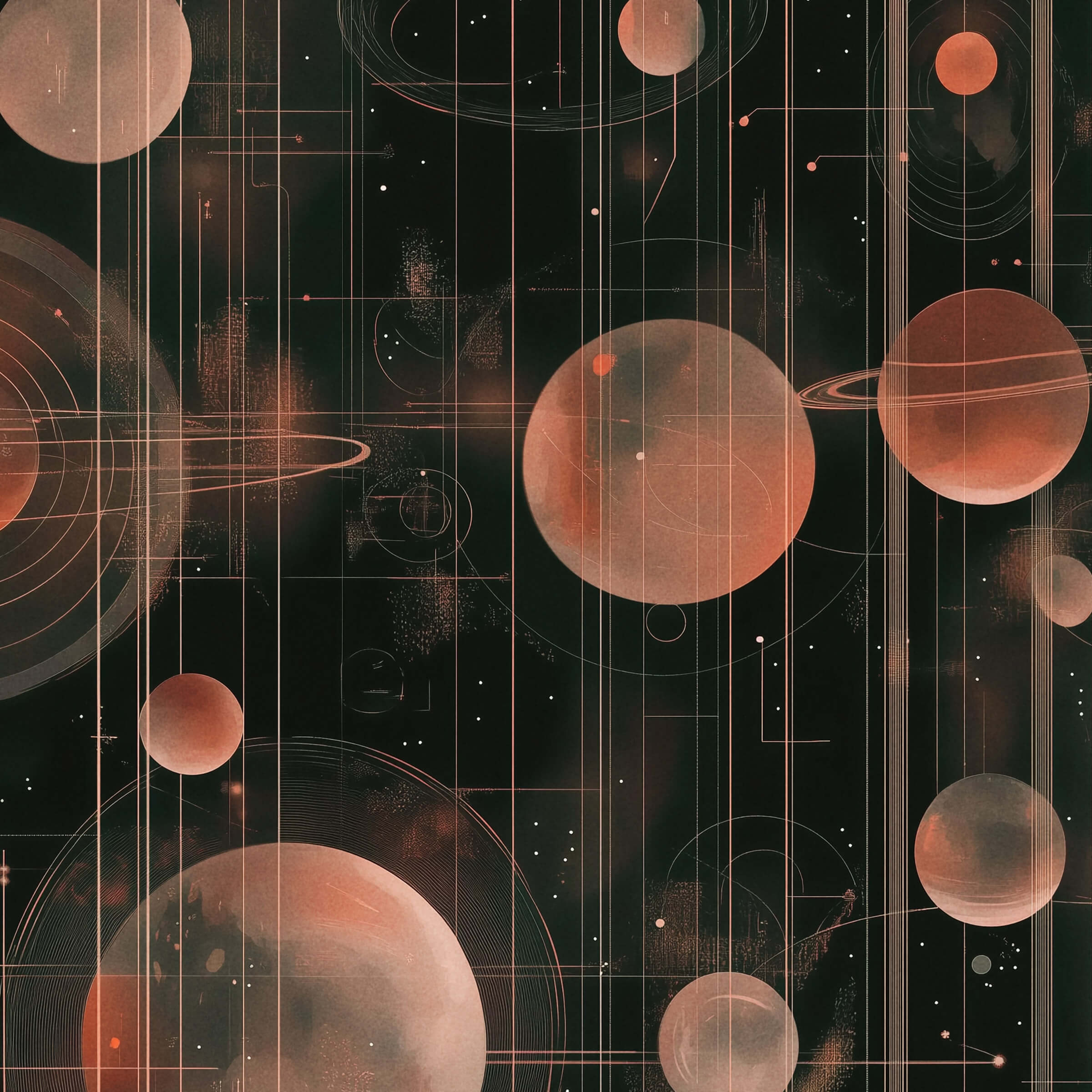
Solar System Fun Facts: A Cosmic Deep Dive Guide
Our solar system is a vibrant neighborhood of extremes, where planets defy expectations, moons hide oceans beneath icy shells, and giant storms rage for centuries. It’s a place where gravity sculpts rings out of ice and rock, and distant clouds of comets mark the edge of the Sun’s reach. Each planet and celestial body tells a unique story, from the fiery landscapes of Venus to the sprawling mysteries of the Oort Cloud. This guide will help you uncover the strange, surprising, and downright awe-inspiring facts about the incredible worlds that orbit our Sun. Start scrolling or use the handy jump-to list to blast off to your favorite celestial body.
Jump to:
Mercury
Venus
Earth
Mars
Jupiter
Saturn
Uranus
Neptune
The Sun
The Asteroid Belt
The Kuiper Belt
Pluto
Ceres
Vesta
The Oort Cloud
Mercury

- Named After: Roman god of commerce, travel, and communication.
- Moons: None!
- Mass: 0.0553 Earth masses
- Size: 0.056 Earth volumes (~9,525 miles in circumference; Earth = ~24,901 miles)
- Distance from the Sun: ~36 million miles (0.39 AU)
- Surface Temperatures: -297°F (-183°C) to 801°F (427°C)
- Gravity: 0.378 times Earth's gravity
- Black Body Temperature: 440 K (167°C or 333°F)
Mercury, the smallest planet in our solar system, is a world of extremes. Its lack of atmosphere leaves it defenseless against the Sun’s radiation, causing daytime temperatures to skyrocket to 801°F (427°C) while nighttime temperatures plummet to -297°F (-183°C)—a swing of nearly 1,100°F. With a year lasting only 88 Earth days, Mercury zips around the Sun faster than any other planet, yet its slow rotation stretches its days to a staggering 176 Earth days. Its dense, oversized metallic core, making up 61% of its volume, contributes to it being the most compact planet in the solar system.
Fun Facts About Mercury
- Mercury has no moons, making it one of only two moonless planets (Venus is the other).
- Standing on Mercury, you’d experience just 38% of Earth’s gravity—jumping would feel almost like slow-motion!
- Sunsets on Mercury are a cosmic oddity: due to its slow rotation and elliptical orbit, the Sun occasionally appears to move backward in the sky.
Venus

- Named After: Roman goddess of love and beauty.
- Moons: None
- Mass: 0.815 Earth masses
- Size: 0.857 Earth volumes (~23,628 miles in circumference; Earth = ~24,901 miles)
- Distance from the Sun: ~67 million miles (0.72 AU)
- Surface Temperatures: -290 °F (-180 °C) to ~867°F (464°C), making it the hottest planet in the solar system
- Gravity: 0.907 times Earth's gravity
- Black Body Temperature: 232 K (-41°C or -42°F)
Venus, often called Earth’s twin, shares a similar size and mass with our home planet, but that’s where the similarities end. It’s the hottest planet in the solar system, with an average surface temperature of 867°F (464°C), thanks to its thick carbon dioxide atmosphere that traps heat in a runaway greenhouse effect. Its clouds, composed mostly of sulfuric acid, reflect sunlight efficiently, making Venus one of the brightest objects in the night sky, often called the "Morning Star" or "Evening Star."
An unusual feature of Venus is its retrograde rotation—unlike most planets, it spins in the opposite direction of its orbit, causing the Sun to rise in the west and set in the east. Its day is longer than its year, with a single rotation taking 243 Earth days, compared to its 225-day orbit around the Sun. These extreme conditions make Venus a fascinating yet inhospitable world.
Fun Facts About Venus
- Venus’s thick atmosphere creates a surface pressure 92 times greater than Earth’s—equivalent to being 3,000 feet underwater!
- The planet’s brightness has inspired many cultural names, including the "Morning Star" and "Evening Star."
- A single day on Venus is longer than its year, as it rotates very slowly in the opposite direction of most planets.
Earth

- Named After: Derived from Old English and Germanic words meaning "ground" or "soil."
- Moons: 1 (Luna)
- Mass: 1 Earth mass (reference)
- Size: 1 Earth volume (~24,901 miles in circumference)
- Distance from the Sun: ~93 million miles (1 AU)
- Surface Temperatures: ~-128°F ( -89°C) to 134°F (57°C)
- Gravity: 1 (this is our baseline reference)
- Black Body Temperature: 255 K (-18°C or -0.4°F)
Earth, the third planet from the Sun, is the only known celestial body capable of supporting complex life. This is largely due to its unique atmosphere, composed of 78% nitrogen and 21% oxygen, which protects life from harmful solar radiation while maintaining a stable climate. Approximately 71% of Earth’s surface is covered by liquid water, a critical element for sustaining life.
Our planet's geology is dynamic, featuring processes such as plate tectonics and volcanism that constantly reshape its surface. Earth’s magnetic field, generated by the motion of molten iron in its core, acts as a protective shield against solar winds and cosmic radiation. Additionally, Earth’s single, relatively large moon, Luna, stabilizes its axial tilt, which helps maintain a consistent climate over time.
Fun Facts About Earth
- Earth is the densest planet in the solar system—it has more mass packed into its size than any other planet, which helps give it its strong gravitational pull.
- Earth is incredibly rare in the universe as a planet that supports life. To date, no other planet has been found with the precise combination of water, atmosphere, and temperature to sustain life as we know it.
- Earth's magnetic field creates stunning auroras when charged particles from the Sun interact with its atmosphere.
Mars

- Named After: Roman god of war, inspired by its reddish hue resembling blood.
- Moons: 2 (Phobos and Deimos)
- Mass: 0.107 Earth masses
- Size: 0.151 Earth volumes (~13,256 miles in circumference; Earth = ~24,901 miles)
- Distance from the Sun: ~142 million miles (1.52 AU)
- Surface Temperature Range: ~-195°F ( -125°C) to 70°F (20°C)
- Gravity: 0.38 times Earth's gravity
- Black Body Temperature: 210 K (-63°C or -81°F)
Mars, the fourth planet from the Sun, is often referred to as the "Red Planet" due to the iron oxide, or rust, on its surface, which gives it a reddish appearance. It’s a cold and dusty world with a thin atmosphere composed mostly of carbon dioxide. Despite its barren surface, evidence of ancient river valleys, lake beds, and polar ice caps suggests that Mars once had liquid water and a much warmer climate.
Mars’s two small moons, Phobos and Deimos, are thought to be captured asteroids. Phobos orbits so closely that it rises and sets twice a day and is slowly spiraling toward Mars, while Deimos has a much more stable orbit. These moons, along with the discovery of subsurface water ice, make Mars an exciting target for exploration, particularly in the search for past or present life.
Fun Facts About Mars
- Mars has the largest volcano in the solar system, Olympus Mons, which is about three times the height of Mount Everest.
- A Martian day, called a sol, is just slightly longer than an Earth day at 24 hours and 39 minutes.
- Dust storms on Mars are the largest in the solar system and can envelop the entire planet for weeks.
Jupiter

- Named After: Roman king of the gods, symbolizing its massive size and prominence.
- Moons: 92 confirmed, including the four largest (Io, Europa, Ganymede, and Callisto)
- Mass: 318 Earth masses
- Size: 1,321 Earth volumes (~272,946 miles in circumference; Earth = ~24,901 miles)
- Distance from the Sun: ~484 million miles (5.2 AU)
- Surface Temperature: ~-234°F (-145°C) at cloud tops
- Gravity: 2.36 times Earth's gravity
- Black Body Temperature: 110 K (-163°C or -261°F)
Jupiter, the largest planet in our solar system, is a gas giant composed mostly of hydrogen and helium. It’s a world of superlatives, with a mass more than twice that of all the other planets combined and the strongest magnetic field of any planet. Jupiter’s fast rotation—completing a day in under 10 hours—creates intense winds and the distinct banded appearance of its atmosphere.
One of Jupiter’s most iconic features is the Great Red Spot, a massive storm larger than Earth that has been raging for centuries. Surrounding the planet is a faint ring system and a vast collection of moons. The four largest, known as the Galilean moons, are diverse and fascinating: Io is the most volcanically active body in the solar system, Europa may harbor a subsurface ocean, Ganymede is the largest moon in the solar system, and Callisto is heavily cratered and ancient.
Fun Facts About Jupiter
- Jupiter’s Great Red Spot has been observed for at least 350 years and could fit Earth inside it.
- If Jupiter were 80 times more massive, it would have become a star rather than a planet.
- The planet emits more heat than it receives from the Sun, likely due to the slow release of gravitational energy from its formation.
Saturn

- Named After: Roman god of agriculture and wealth, symbolizing time and abundance.
- Moons: 146 confirmed, including notable ones like Titan and Enceladus
- Mass: 95.16 Earth masses
- Size: 764 Earth volumes (~227,349 miles in circumference; Earth = ~24,901 miles)
- Distance from the Sun: ~890 million miles (9.5 AU)
- Surface Temperature: ~-288°F (-178°C) at cloud tops
- Gravity: 1.07 times Earth's gravity
- Black Body Temperature: 81 K (-192°C or -314°F)
Saturn, the second-largest planet in the solar system, is best known for its iconic ring system, which is made up of countless ice particles, rocks, and dust. These rings, stretching thousands of miles wide, are divided into several sections and remain one of the most visually stunning features of the solar system. Saturn is a gas giant composed mainly of hydrogen and helium, with no solid surface.
Beyond its rings, Saturn boasts a remarkable collection of moons. Titan, its largest moon, has a dense atmosphere and liquid hydrocarbon lakes, while Enceladus is famous for its geysers that eject water vapor and organic compounds—indications of a subsurface ocean. Despite its massive size, Saturn has an incredibly low density and would float in water, if such a massive body could be placed in a sufficiently large pool!
Fun Facts About Saturn
- Saturn’s rings are so wide that they could stretch almost halfway between Earth and the Moon, yet they are only about 30 feet thick in most places.
- A day on Saturn is incredibly short, lasting just 10.7 hours despite the planet’s size.
- Titan, Saturn’s largest moon, is bigger than the planet Mercury and has a thick atmosphere rich in nitrogen.
Uranus

- Named After: Greek god of the sky, the only planet named after a Greek deity.
- Moons: 27 confirmed, including Titania, Oberon, Ariel, Umbriel, and Miranda
- Mass: 14.54 Earth masses
- Size: 63 Earth volumes (~99,018 miles in circumference; Earth = ~24,901 miles)
- Distance from the Sun: ~1.78 billion miles (19.2 AU)
- Surface Temperature: ~-371°F (-224°C) at cloud tops
- Gravity: 0.89 times Earth's gravity
- Black Body Temperature: 58 K (-215°C or -355°F)
Uranus, the seventh planet from the Sun, stands out in the solar system for its extreme axial tilt of 97.8 degrees, causing it to rotate on its side. This unusual tilt results in unique seasons, with each pole experiencing 42 years of continuous sunlight followed by 42 years of darkness. Known as an ice giant, Uranus is composed primarily of water, ammonia, and methane ice, with methane giving the planet its characteristic blue-green color.
Its moons are named after characters from Shakespeare and Alexander Pope, with Miranda being particularly fascinating due to its dramatic cliffs and canyons. Uranus also has faint rings that are darker and less pronounced than those of Saturn. Despite its serene appearance, Uranus holds the title of the coldest planet in the solar system, with an average temperature of -371°F (-224°C).
Fun Facts About Uranus
- Uranus’s extreme axial tilt means it essentially rolls around the Sun like a barrel rather than spinning upright like other planets.
- Despite being far from the Sun, Uranus emits almost no internal heat, making its atmosphere unusually cold.
Neptune

- Named After: Roman god of the sea, inspired by its vivid blue color reminiscent of ocean waters.
- Moons: 14 confirmed, including the largest, Triton
- Mass: 17.15 Earth masses
- Size: 57 Earth volumes (~96,685 miles in circumference; Earth = ~24,901 miles)
- Distance from the Sun: ~2.79 billion miles (30.1 AU)
- Surface Temperature: ~-373°F (-225°C) at cloud tops
- Gravity: 1.12 times Earth's gravity
- Black Body Temperature: 47 K (-226°C or -375°F)
Neptune, the eighth and farthest planet from the Sun, is an ice giant known for its striking deep blue color, caused by methane in its atmosphere. It boasts the fastest winds in the solar system, reaching speeds of over 1,200 mph, and hosts massive storms like the Great Dark Spot, a temporary feature similar to Jupiter’s Great Red Spot. Despite being so far from the Sun, Neptune radiates more heat than it receives, likely due to the slow release of internal energy.
Triton, Neptune’s largest moon, is particularly fascinating with its retrograde orbit, which suggests it was a captured object from the Kuiper Belt. Triton also features active nitrogen geysers and an icy surface, making it one of the most intriguing moons in the solar system. Neptune’s faint ring system and dynamic atmosphere add to its mystique and scientific interest.
Fun Facts About Neptune
- Neptune’s winds are the fastest in the solar system, blowing over 1,200 mph—stronger than a Category 5 hurricane.
- It takes Neptune approximately 165 Earth years to complete one orbit around the Sun. It has only completed one full orbit since its discovery in 1846!
- Triton, Neptune’s largest moon, orbits in the opposite direction of the planet’s rotation, a rare phenomenon among large moons.
The Sun

- Named After: Derived from Old English "sunne" and Proto-Germanic "sunnō," describing the star that provides light and warmth.
- Moons: None
- Mass: 333,000 Earth masses
- Size: 1.3 million Earth volumes (~2,713,406 miles in circumference; Earth = ~24,901 miles)
- Distance from Earth: ~93 million miles (1 AU)
- Surface Temperature: ~9,941°F (5,505°C)
- Gravity: 27.94 times Earth's gravity
The Sun, our solar system's central star, accounts for 99.86% of its total mass, making it the gravitational anchor for all planets, asteroids, and comets. It is a G-type main-sequence star that generates energy through nuclear fusion in its core, where hydrogen atoms combine to form helium, releasing immense energy in the process. This energy takes thousands of years to travel from the core to the surface before radiating into space as sunlight.
The Sun’s surface, or photosphere, is constantly shifting due to solar activity, including sunspots and solar flares. Its outermost layer, the corona, extends millions of miles into space and is hotter than the surface—a phenomenon that continues to puzzle scientists. Solar winds from the Sun interact with Earth’s magnetic field to create auroras and occasionally disrupt satellite and communication systems.
Fun Facts About The Sun
- The Sun's core temperature reaches an astounding 27 million°F (15 million°C), where nuclear fusion occurs.
- Every second, the Sun converts about 4 million tons of matter into energy, fueling its brightness.
- If the Sun were hollow, it could fit about 1.3 million Earths inside it.
Explore the Solar System Chart
As both researchers and designers, we made a nifty print design capturing the essential (and more interesting!) stats about our solar system.
You can check out this Solar System Chart poster here. Now back to the stars!
The Asteroid Belt
- Name Origin: Named for its location as a belt-like region of space between Mars and Jupiter.
- Asteroid Count: Billions of objects, ranging from dust-sized particles to the dwarf planet Ceres
- Mass: ~0.04 Earth masses (less than 4% of the Moon’s mass)
- Distance from the Sun: ~186 million to 370 million miles (2 to 4 AU)
- Black Body Temperature: ~170 K (-153°C or -243°F)
The Asteroid Belt is a vast region of space between the orbits of Mars and Jupiter, filled with rocky and metallic objects. Despite its dramatic name, the belt is mostly empty space, with an average distance of 600,000 miles between objects. The largest member, the dwarf planet Ceres, accounts for about one-third of the belt’s total mass. Many other asteroids are irregularly shaped fragments resulting from ancient collisions.
The belt’s formation is believed to be the result of Jupiter’s strong gravity, which prevented material in this region from coalescing into a planet. Asteroids in this region vary greatly in composition, with some being rich in metals like nickel and iron, while others are carbonaceous, containing organic compounds. These characteristics make the Asteroid Belt a significant focus for understanding the early solar system and its building blocks.
Fun Facts About The Asteroid Belt
- If all the asteroids in the belt were combined into one body, it would still be smaller than Earth’s Moon.
- The spacecraft Dawn explored two key bodies in the belt: Vesta, a protoplanet, and Ceres, a dwarf planet.
- The belt is not as dangerous as movies portray—asteroids are so far apart that navigating through it is relatively straightforward for spacecraft.
The Kuiper Belt
- Name Origin: Named after Gerard Kuiper, who hypothesized its existence as a region of icy bodies beyond Neptune.
- Asteroid/Body Count: Hundreds of thousands of icy bodies larger than 60 miles (100 km) across, and millions of smaller ones
- Mass: ~0.01 to 0.1 Earth masses (exact mass is uncertain)
- Distance from the Sun: ~2.7 billion to 9.3 billion miles (30 to 100 AU)
- Black Body Temperature: ~50 K (-223°C or -370°F)
The Kuiper Belt is a vast, doughnut-shaped region of icy bodies that lies beyond Neptune's orbit. It is home to dwarf planets such as Pluto, Haumea, and Makemake, as well as countless smaller objects made of frozen water, methane, and ammonia. This region is the source of short-period comets, which have orbits lasting less than 200 years.
The discovery of the Kuiper Belt in the 1990s reshaped our understanding of the solar system, leading to the reclassification of Pluto as a dwarf planet. Kuiper Belt objects are some of the most primitive materials in the solar system, offering clues about the conditions that existed during its formation. NASA’s New Horizons mission, which flew past Pluto in 2015, revealed the complex and surprising diversity of this region.
Fun Facts About The Kuiper Belt
- The Kuiper Belt contains over three times the mass of the asteroid belt, though its objects are spread over a much larger area.
- Pluto and other dwarf planets in the Kuiper Belt are sometimes called "plutoids."
- The Kuiper Belt is the birthplace of Halley's Comet and other short-period comets.
Pluto
- Named After: Roman god of the underworld, reflecting its cold and dark location at the edge of the solar system.
- Moons: 5 (Charon, Nix, Hydra, Kerberos, Styx)
- Mass: 0.002 Earth masses (about 1/6 the mass of Earth’s Moon)
- Size: 0.006 Earth volumes (~4,494 miles in circumference; Earth = ~24,901 miles)
- Distance from the Sun: ~3.7 billion miles (39.5 AU)
- Surface Temperature: ~-375°F to -400°F (-226°C to -240°C)
- Gravity: 0.063 times Earth's gravity
Pluto, once considered the ninth planet in our solar system, was reclassified as a dwarf planet in 2006. Despite its small size, Pluto is a fascinating world with a complex surface and active geology. Its most prominent moon, Charon, is so large compared to Pluto that the two form a binary system, orbiting a shared center of gravity outside of Pluto itself.
Pluto’s icy surface is covered in nitrogen, methane, and carbon monoxide, and features towering ice mountains and vast plains. Observations from the New Horizons mission in 2015 revealed evidence of cryovolcanism and a surprisingly youthful surface, suggesting ongoing geological activity. Pluto’s orbit is highly elliptical, occasionally bringing it closer to the Sun than Neptune.
Fun Facts About Pluto
- A day on Pluto lasts 6.4 Earth days, the same time it takes for its moon Charon to orbit it.
- Pluto’s heart-shaped glacier, called Tombaugh Regio, is made of nitrogen ice and is a defining feature of its surface.
- If you weigh 100 pounds on Earth, you’d weigh just 6 pounds on Pluto due to its low gravity.
Ceres
- Named After: Roman goddess of agriculture and fertility, symbolizing its connection to water and potential for life.
- Moons: None
- Mass: 0.00015 Earth masses (about 1/25 the mass of Earth’s Moon)
- Size: 0.0004 Earth volumes (~1,920 miles in circumference; Earth = ~24,901 miles)
- Distance from the Sun: ~257 million miles (2.8 AU)
- Surface Temperature Range: ~-243°F to -225°F (-153°C to -143°C)
- Gravity: 0.028 times Earth's gravity
Ceres, the largest object in the asteroid belt and the only dwarf planet in this region, is a small but significant world. Its surface features bright spots composed of sodium carbonate, evidence of briny liquid water that may have reached the surface through cryovolcanism. Beneath its crust lies a layer of water ice, raising questions about the potential for microbial life.
Ceres also has a thin exosphere containing water vapor, likely released by sublimation or cryovolcanic activity. Observations from NASA’s Dawn mission revealed a complex geology, including craters, mountains, and regions that suggest past or ongoing geological activity. Its unique combination of size, water presence, and location makes Ceres a compelling object of study for planetary scientists.
Fun Facts About Ceres
- Ceres accounts for roughly one-third of the total mass of the asteroid belt.
- The bright spots on its surface, such as those in the Occator Crater, are visible from space and were a major mystery until the Dawn mission.
- Ceres is the smallest dwarf planet in our solar system, yet it’s the largest object in the asteroid belt.
Vesta
- Named After: Roman goddess of home and hearth, symbolizing its fiery and rocky nature.
- Moons: None
- Mass: 0.0003 Earth masses (about 1/10 the mass of Ceres)
- Size: 0.0008 Earth volumes (~1,590 miles in circumference; Earth = ~24,901 miles)
- Distance from the Sun: ~230 million miles (2.3 AU)
- Surface Temperature Range: ~-200°F to -20°F (-129°C to -29°C)
- Gravity: 0.022 times Earth's gravity
Vesta, one of the largest objects in the asteroid belt, is often referred to as a protoplanet due to its differentiated interior, which includes a core, mantle, and crust. Its bright surface, primarily composed of basaltic rock, reflects sunlight more effectively than most other asteroids. Vesta’s surface features include deep craters, steep cliffs, and massive impact basins like Rheasilvia, which spans 310 miles and is believed to have formed from a colossal collision.
This impact sent debris into space, creating a family of smaller asteroids and contributing meteorites that have fallen to Earth. Vesta’s volcanic past, evidenced by lava flows, sets it apart from many other objects in the asteroid belt, offering valuable insights into planetary formation processes in the early solar system.
Fun Facts About Vesta
- Vesta is so bright that it’s occasionally visible to the naked eye from Earth under dark skies.
- It is the only known asteroid with a differentiated interior similar to terrestrial planets like Earth.
- Pieces of Vesta, known as HED meteorites, have been found on Earth, making it one of the few celestial bodies we’ve physically studied without visiting.
The Oort Cloud
- Named After: Dutch astronomer Jan Oort, who proposed its existence as the source of long-period comets.
- Asteroid/Body Count: Estimated to contain trillions of icy objects and potential comets
- Mass: Unknown, but potentially several Earth masses
- Distance from the Sun: ~2,000 AU to 100,000 AU (outer edge)
- Black Body Temperature: ~4 K (-269°C or -452°F)
The Oort Cloud is a hypothetical, spherical shell of icy bodies surrounding the solar system at its farthest reaches. Unlike the Kuiper Belt, which lies in the plane of the solar system, the Oort Cloud extends in all directions, forming a vast boundary that is more than a thousand times farther away from the Sun than Neptune. It is believed to be the source of long-period comets, which have highly elliptical orbits that can take thousands to millions of years to complete.
The Oort Cloud is thought to contain remnants from the solar system’s formation, ejected outward by gravitational interactions with the giant planets. Although no direct observations have been made, its existence is supported by the trajectories of comets like Hale-Bopp. Understanding the Oort Cloud could offer insights into the processes that shaped the solar system’s outermost regions.
Fun Facts About The Oort Cloud
- If the Sun were the size of a marble, the Oort Cloud would extend about 12 miles away at scale.
- Long-period comets from the Oort Cloud are some of the oldest objects in the solar system, formed over 4.6 billion years ago.
- The Oort Cloud is so vast and distant that light from the Sun takes more than a year to reach its outer edge.
The solar system is a treasure trove of fascinating details and mind-boggling phenomena, and we’ve only scratched the surface (Psst, here's a nifty solar system chart for all you explorers). From scorching planets to icy belts, it’s a dynamic, ever-evolving system with endless stories to tell. If you enjoyed this journey, why stop here? Check out our post on Fun Facts About the Aurora Borealis to learn about the dazzling light shows created by solar winds. Or, take a deeper dive into the quirks of natural satellites with Fun Facts About Moons—because there’s a lot more to moons than meets the eye.
For more in-depth exploration of the solar system, check out these excellent resources: HubbleSite, The Planetary Society, NASA Jet Propulsion Laboratory, European Space Agency (ESA), NASA, NASA Solar System Exploration.






